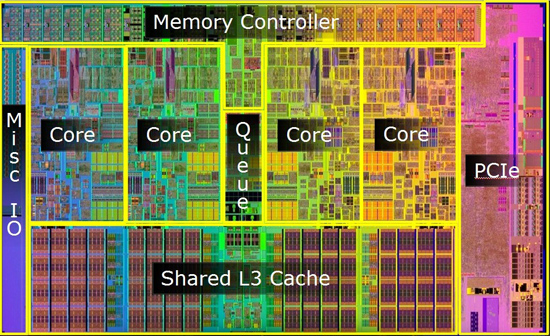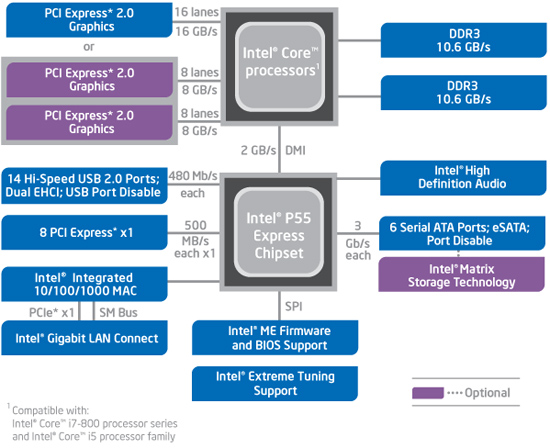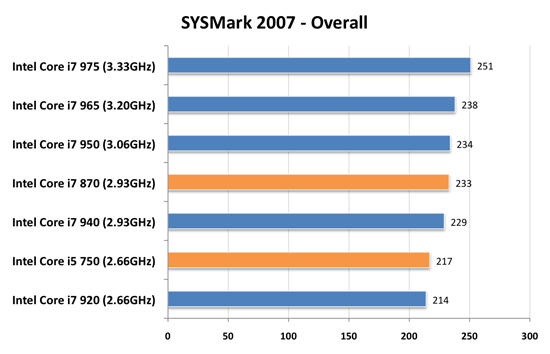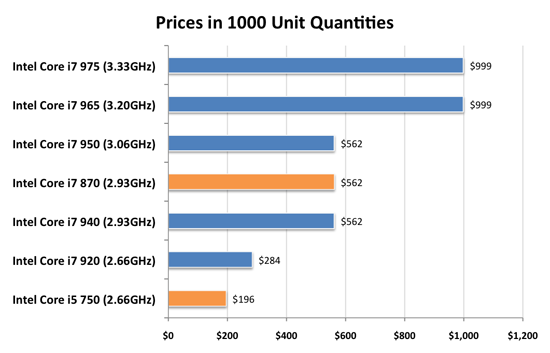Intel's Core i7 870 & i5 750, Lynnfield: Harder, Better, Faster Stronger
by Anand Lal Shimpi on September 8, 2009 12:00 AM EST- Posted in
- CPUs
Intel is on the verge of transitioning to 32nm. We'll see the first parts this year. What do you do with your 45nm fabs when you start moving volume away from them? Make really cheap quad-core Nehalems of course:

I'm talking $196. I'm talking faster than AMD's entire lineup. I'm talking about arguably the best processor of 2009. I'm talking about Lynnfield, and here's its backside:

Mmm
I spent much of the past year harping on AMD selling Nehalem-sized Phenom IIs for less than Intel sold Nehalems. With Lynnfield, Intel actually made Nehalem even bigger all while driving prices down. Like I said, what do you do when you're still making boatloads of money in a recession and are about to start emptying your 45nm fabs?
I should clear things up before we progress much further. Lynnfield is the codename for mainstream 45nm quad-core Nehalem, while Bloomfield refers to the first Nehalem launched at the end of 2008:
| Processor | Manufacturing Process | Die Size | Transistor Count | Socket |
| Bloomfield | 45nm | 263 mm2 | 731M | LGA-1366 |
| Lynnfield | 45nm | 296 mm2 | 774M | LGA-1156 |
Despite being cheaper, Lynnfield is larger than Bloomfield. The larger die is due to one major addition: an on-die PCIe controller.

Bloomfield, The First Nehalem, circa 2008

Lynnfield, Nehalem for All, circa 2009
The pink block to the right of the die is the PCIe controller, that's 16 PCIe 2.0 lanes coming right off the chip. Say hello to ultra low latency GPU communication. You'd think that Intel was about to enter the graphics market or something with a design like this.
Sacrifices were made to reduce CPU, socket and board complexity. Gone are the two QPI links that each provided 25.6GB/s of bandwidth to other CPUs or chips on the motherboard. We also lose one of the three 64-bit DDR3 memory channels, Lynnfield only has two like a normal processor (silly overachieving Bloomfield).

Intel's Bloomfield Platform (X58 + LGA-1366)
The sum is that Lynnfield is exclusively single-socket; there will be no LGA-1156 Skulltrail. While the dual-channel memory controller isn't really a limitation for quad-core parts, six and eight core designs may be better suited for LGA-1366.

Intel's Lynnfield Platform (P55 + LGA-1156)
The loss of QPI means that Lynnfield doesn't have a super fast connection to the rest of the system, but with an on-die PCIe controller it doesn't matter: the GPU is fed right off the CPU.
The Lineup
We get three Lynnfield CPUs today: the Core i7 870, Core i7 860 and the Core i5 750. Intel's branding folks told us that the naming would make sense one we saw the rest of the "Core" parts introduced; yeah that was pretty much a lie. At least there aren't any overlapping part numbers (e.g. Core i5 860 and Core i7 860).
The i7 in this case denotes four cores + Hyper Threading, the i5 means four cores but no Hyper Threading. The rules get more complicated as you bring notebooks into the fray but let's momentarily bask in marginal simplicity.
| Processor | Clock Speed | Cores / Threads | Maximum Single Core Turbo Frequency | TDP | Price |
| Intel Core i7-975 Extreme | 3.33GHz | 4 / 8 | 3.60GHz | 130W | $999 |
| Intel Core i7 965 Extreme | 3.20GHz | 4 / 8 | 3.46GHz | 130W | $999 |
| Intel Core i7 940 | 2.93GHz | 4 / 8 | 3.20GHz | 130W | $562 |
| Intel Core i7 920 | 2.66GHz | 4 / 8 | 2.93GHz | 130W | $284 |
| Intel Core i7 870 | 2.93GHz | 4 / 8 | 3.60GHz | 95W | $562 |
| Intel Core i7 860 | 2.80GHz | 4 / 8 | 3.46GHz | 95W | $284 |
| Intel Core i5 750 | 2.66GHz | 4 / 4 | 3.20GHz | 95W | $196 |
Keeping Hyper Threading off of the Core i5 is purely done to limit performance. There aren't any yield reasons why HT couldn't be enabled.
Intel was very careful with both pricing and performance of its Lynnfield processors. I'm going to go ahead and say it right now, there's no need for any LGA-1366 processors slower than a Core i7 965:

This is only one benchmark, but it's representative of what you're about to see. The Core i7 870 (LGA-1156) is as fast, if not faster, than every single LGA-1366 processor except for the ones that cost $999. Its pricing is competitive as well:

For $196 you're getting a processor that's faster than the Core i7 920. I'm not taking into account motherboard prices either, which are anywhere from $50 - $100 cheaper for LGA-1156 boards. I don't believe LGA-1366 is dead, but there's absolutely no reason to buy anything slower than a 965 if you're going that route.










343 Comments
View All Comments
goinginstyle - Tuesday, September 8, 2009 - link
Really? SuperPi, WPrime, Everest, 3Dmarks and LN2 overclocking defines a better review? How does any of that correlate into real world applications and what 99% of people use their computers for on a daily basis. I counted a lot more than three tests in the AT review, go spam elsewhere.C'DaleRider - Tuesday, September 8, 2009 - link
Really. All I play is SuperPi, Everest and 3DMarks....oh, and Furmark and OCCT.Who would ever use their computer to encode video, run Excel spreadsheets, play games like Far Cry or Crysis or Left For Dead, or actually use any other real world application?
Don't you know? Real elite computer users just bench synthetic crap, over and over, for hours and hours, and scoff at anyone who dares do anything productive with their computer.
/sarcasm
geok1ng - Tuesday, September 8, 2009 - link
I am not pleased by the news; i5 needs more juice for overcloking. Thats terrible: my E8600 is still on top: it runs at 4.0Ghz with 1.16v on a watercooled setup with 4x120mm fans at 1600rpm. we are talking less than 30dB of noise and less than 55w of power consumption. At 1.25v my E8600 reaches 4.25Ghz and would go a little further if wasnt for the 4 sticks of ram burning the NB. no reason to exchange systems before the 32nm parts arrive. The ability to achieve high clocks with low voltages is crucial for a good system: not only will it consume less power, but it will also be quieter, and that is a point for choosing sub-65w dual-cores in gaming rigs.papapapapapapapababy - Tuesday, September 8, 2009 - link
honestly... i lol at all the core i7 core i5 "GAMERS"( and their punny 23 lcd with shitty TN panels) also LGA1366? LGA1156? and 285$ for a shitty motherboard? XD I have a better proposition for you INTEL. how about u SUCK MY BALLS XD. MKAY? the story: my old man needed a gaming setup ( mostly simracing) So i bought the cheapest E7200 i could find (oc3.2GHZ), 4gb of ram, the cheapest intel mobo i could find -g31- ( not even pcie2) and gave him my 4770 ... the price? ridiculously cheap... almost nothing. and with all that extra money i saved i got this > a nice 42" HDTV with a perfect s-ips panel and low 1366 X 768 resolution, and a g25 wheel.
btw, the framerates? i never, ever drop below 30fps. ALWAYS 60FPS NO MATTER WHAT, ( with nice 8xAA) XD so the best gaming cpu? the cheapest !
erple2 - Tuesday, September 8, 2009 - link
Interesting. Which 42" LCD TV did you get that has a S-IPS panel? Also, a 23" panel at about 3 feet looks bigger than a 42" screen at 6 feet.papapapapapapapababy - Tuesday, September 8, 2009 - link
LG. btw a 23" TN lcd looks like shit no matter how you look at it.C'DaleRider - Tuesday, September 8, 2009 - link
My, aren't you special?papapapapapapapababy - Tuesday, September 8, 2009 - link
yes, i know! btw enjoy your small screen gaming, mr sheep XDchrnochime - Tuesday, September 8, 2009 - link
I'd say the same about that barely big enough 42" LCD, but then again why bother...papapapapapapapababy - Tuesday, September 8, 2009 - link
my bad i meant this > E7300 3.2ghz (+ a cheap 24$ modded heatpipe cooler... 14 dba XD)